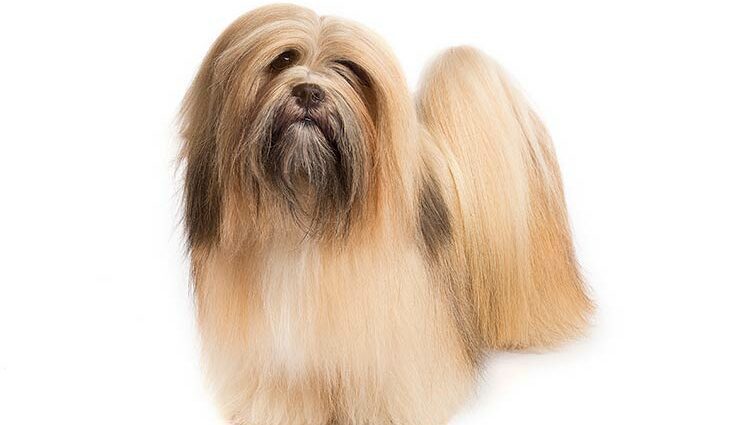Contents
Lhasa Apso
Physical Characteristics
The Lhasa Apso is a small pleasure dog of about 6 to 8 kg for 25 cm in males. The female is slightly smaller. Its head is covered with an abundant coat, which falls down to the eyes but without affecting its vision. This straight, wiry topcoat is long and abundant over the entire body. It can be many colors: golden, sand, honey, dark gray, ect.
The Fédération Cynologique Internationale classifies him in Group 9 of Companion and Companion Dogs and Section 5, Dogs of Tibet.
Origins and history
The Lhasa Apso is native to the mountains of Tibet and its first appearance in Europe dates back to 1854, in the United Kingdom. At that time there was however a lot of confusion between this breed and the Tibetan Terrier, The first description of this dog was finally published in 1901 by Sir Lionel Jacob, under the name of Lhasa Terrier. Shortly afterwards, in the 1930s, a Lhasa Apso breed club was founded in Great Britain. The breed’s name changed several times until the 1970s, eventually establishing itself as the Lhasa Apso. The modern standard of the breed was also established a few years later.
Character and behavior
Take special care to educate your dog very young because the Lahssa Aspo has a tendency to bark a lot and can develop a capricious behavior if it is not taken in hand from an early age.
The standard of the International Cynological Federation describes him as a dog “Cheerful and sure of himself.” Lively, stable but showing a certain distrust of strangers. “
Suspicious by nature, this does not mean that he is shy or aggressive. Be careful though to remember when you approach him that his peripheral vision may be limited by his long coat and that it may therefore be good to signal himself or not to move his hand too quickly at the risk of scaring him.
Frequent pathologies and diseases of Lhasa Apso
According to the Kennel Club UK Purebred Dog Health Survey 2014, the Lhasa Apso can last up to 18 years and their primary cause of death or euthanasia is old age. However, like other purebred dogs, it can have some congenital illnesses:
Progressive retinal atrophy
This disease characterized by progressive degeneration of the retina is very similar between dogs and humans. Ultimately, it causes permanent loss of vision and possibly a change in the color of the eyes, which appear green or yellow to them. Both eyes are affected, more or less simultaneously and equally.
In the Lhasa Apso, the diagnosis is possible around the age of 3 and consists, as for other dogs, of an ophthalmological examination. The electroretinogram could allow earlier detection. Unfortunately there is no cure for this disease and blindness is currently inevitable. (2)
Congenital hydrocephalus
Congenital hydrocephalus is a condition caused by the dilation of the cerebral ventricular system which causes an increase in intracranial pressure. The ventricular system allows in particular the circulation of cerebrospinal fluid and it is too much of this fluid that causes dilation and increase in pressure. The signs are visible from birth or appear in the months that follow. In particular, there is an enlargement of the cranial box and signs due to intracranial hypertension, such as, for example, a decrease in vigilance or an abnormality in the carriage of the head. The impairment of neurological functions can also lead to growth retardation, lethargy, daze, locomotor difficulties, visual impairment or even convulsions.
Age and race predisposition are critical to the diagnosis, but a complete neurologic examination and x-ray are needed to confirm this.
Initially, it is possible to reduce the production of cerebrospinal fluid and therefore to decrease intracranial pressure by diuretics, corticosteroids or carbonic anhydrase inhibitors. It is also possible to improve the comfort of the animal with anticonvulsants in particular. Second, there are surgical treatments that can help manage excess cerebrospinal fluid. However, the success of surgeries remains limited when hydrocephalus is congenital. Thus, it is often advisable to euthanize animals with strong congenital hydrocephalus and severe neurological damage. (3)
Entropion
Entropion is an eye condition that affects the eyelids. More exactly, it is a rolling inward direction of the free edge of the lower or upper eyelid, or both. It most often affects both eyes and causes contact of the eyelashes with the cornea. Symptoms are variable and can be quite minimal to very severe depending on the corneal involvement.
The distant examination makes it possible to see the coiling of the entropion eyelid and the use of a slit lamp makes it possible to locate the eyelashes oriented towards the cornea. Damage to the latter can then be visualized by a biomicroscope.
Treatment is surgical to completely reduce entropion and medication for the symptoms of the cornea.
In Lhasa Apso, cases of trichiasis, with or without entropion, have also been reported. In this case, the eyelashes are correctly implanted but abnormally curved so that they are then oriented towards the cornea. The methods of diagnosis and treatment are the same. (4)
See the pathologies common to all dog breeds. |
Living conditions and advice
The Lhasa Apso is reputed to have been selected to accompany caravans in the Himalayas and prevent them from avalanches. It will therefore certainly surprise you with its robustness. The harsh climate and altitude of its region of origin, Tibet, made it a resistant little dog and its long coat coupled with an insulating undercoat allows it to withstand low winter temperatures. It will thus adapt as well to city life as to the countryside. Its long coat will however require some attention and regular brushing.










